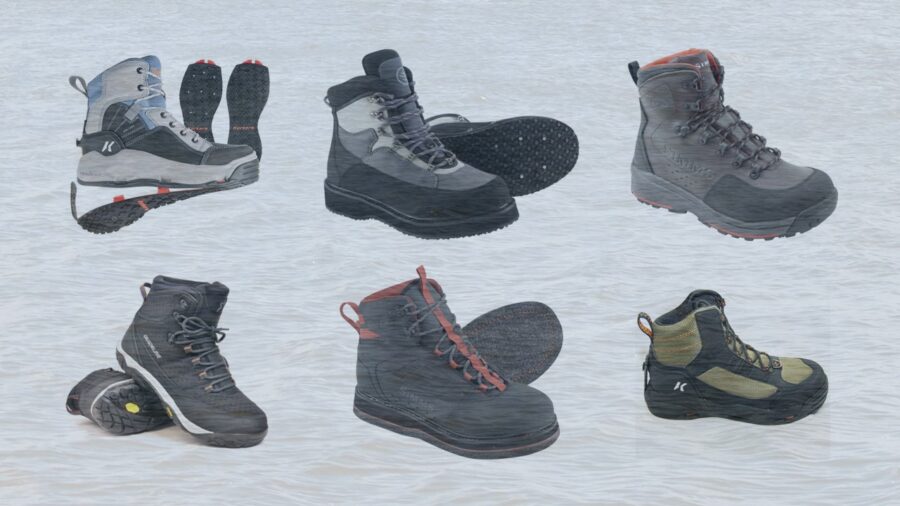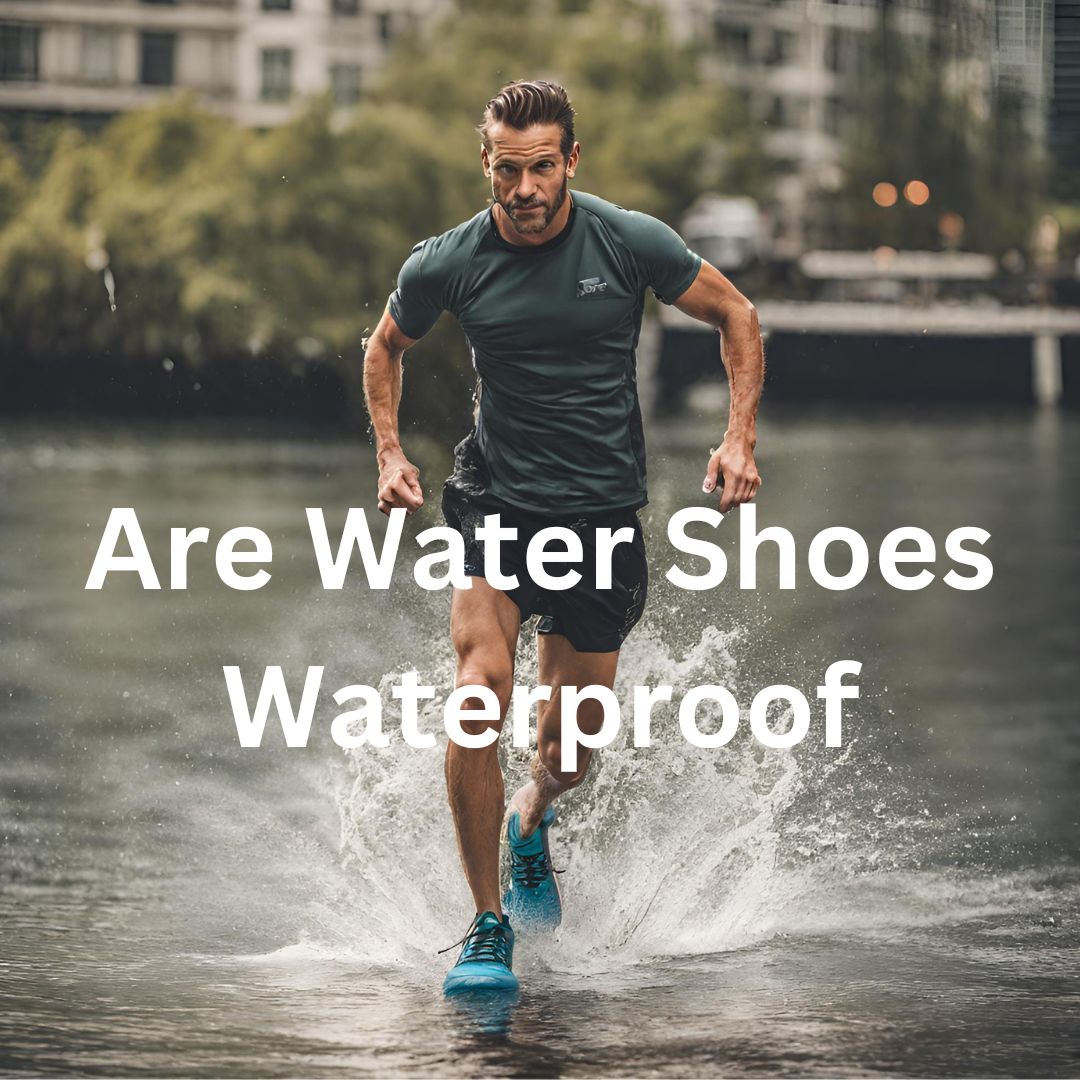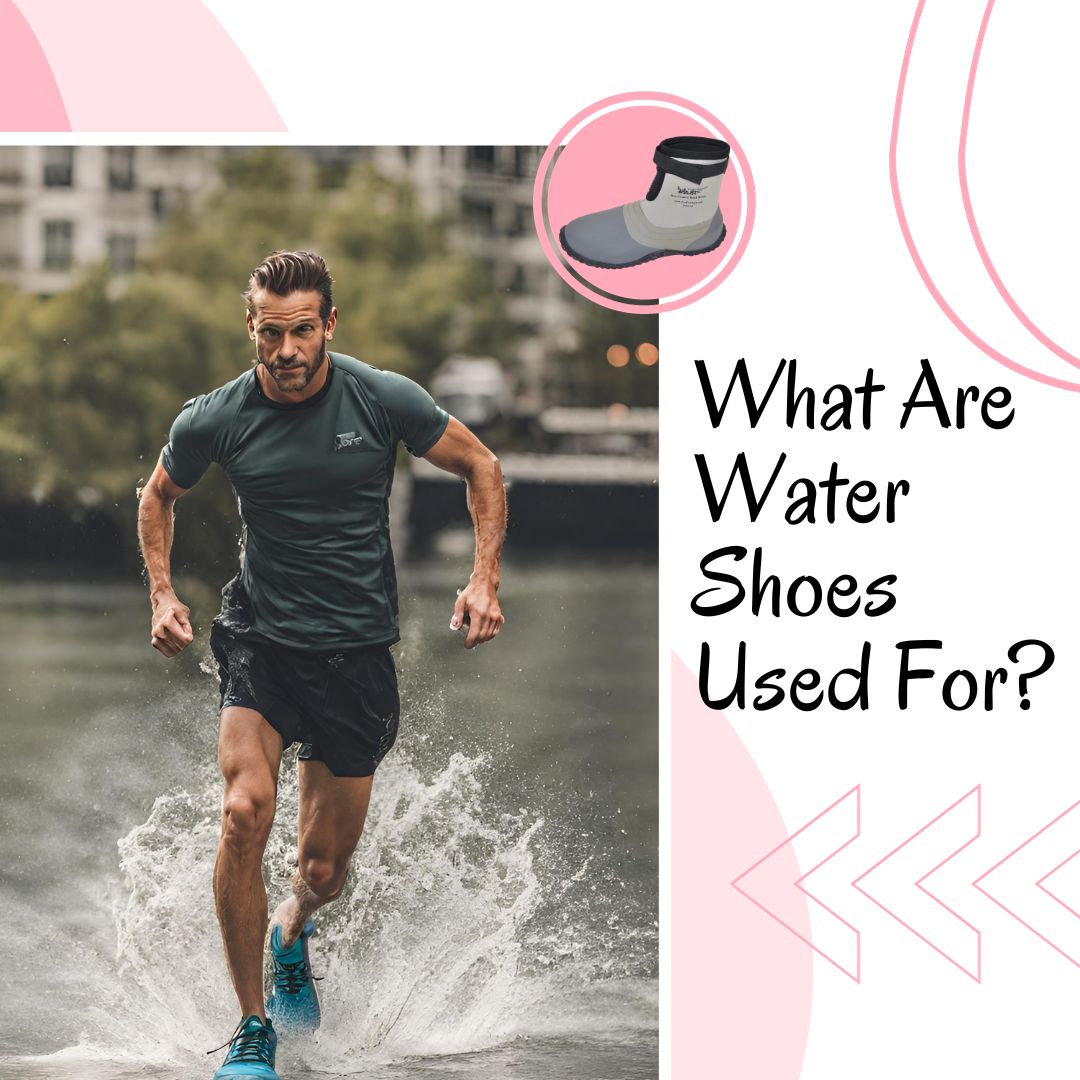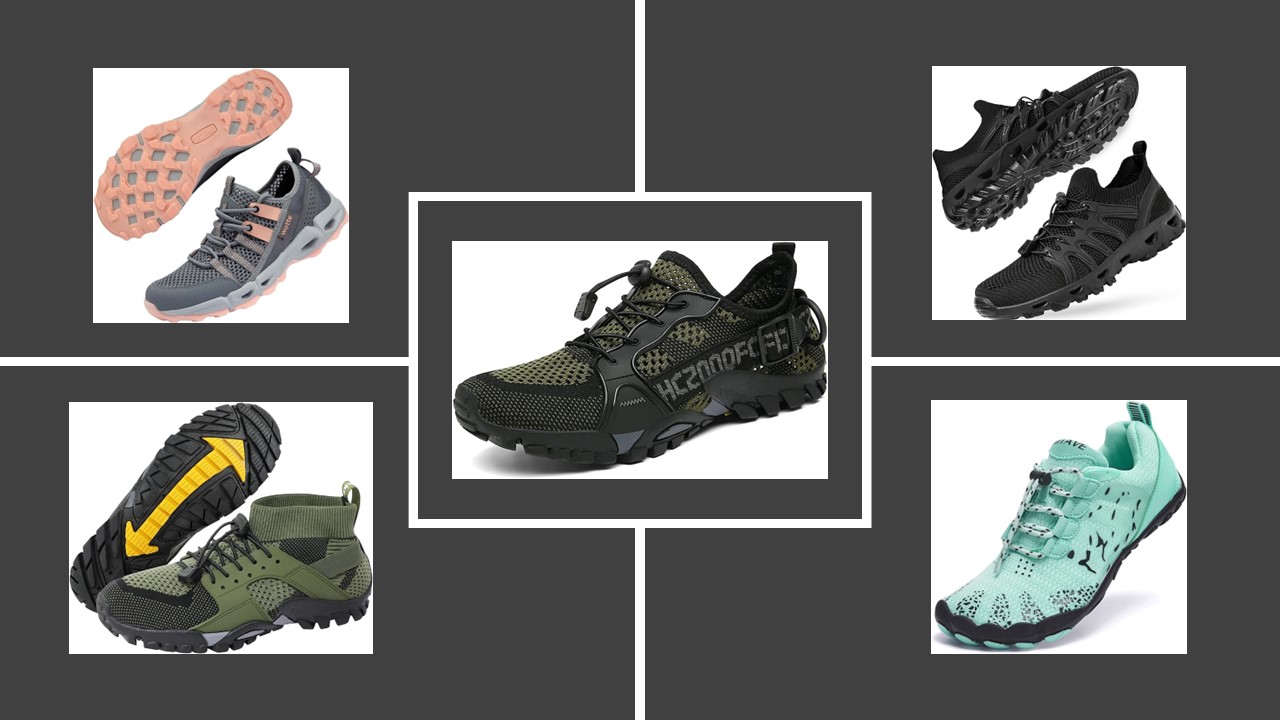What Are Wading Boots: The Secret To Ultimate Fishing Success
What are wading boots? Wading boots are specialized footwear for exploring water bodies like rivers and lakes, favored by anglers and outdoor enthusiasts. Crafted with durable materials, these boots provide stability, support, and protection, enabling safe journeys in tranquil shallows and swirling currents.
While wading boots offer a gateway to aquatic adventures, not donning them can lead to perilous consequences. From treacherous slips on slippery rocks to painful encounters with sharp underwater debris, the dangers of not wearing wading boots during water-bound escapades are all too real.
In this comprehensive guide, we’ll delve deep into the world of wading boots, leaving no stone unturned. Whether you’re a seasoned angler seeking to upgrade your gear or a nature enthusiast looking to unlock the enchanting beauty of aquatic ecosystems, we’ve got you covered.
What Are Wading Boots?
Wading boots are a specialized form of footwear designed for activities that involve wading through water bodies like rivers, streams, and lakes.
They are commonly used by anglers, hikers, and other outdoor enthusiasts who need to traverse water and slippery surfaces while maintaining stability and protecting their feet.
These boots are constructed with durable and water-resistant materials to withstand the harsh conditions encountered in aquatic environments.
They feature sturdy outsoles that provide excellent traction on slippery rocks and other uneven surfaces commonly found in water bodies. Wading boots often have a high-top design to offer additional protection against water entering the boots and to prevent debris from getting inside.
The primary purpose of wading boots is to provide support, stability, and protection for the feet while walking through water. They are especially popular among anglers who fish in rivers or streams, as wading boots allow them to maintain their footing in fast-flowing currents and provide enhanced traction on slippery riverbeds.
Additionally, these boots are designed to be worn with waders, which are waterproof pants that cover the lower body, ensuring that outdoor enthusiasts can stay dry and comfortable while wading through water.
Key characteristics of wading boots include:
- Durable Materials: Wading boots are constructed using durable and water-resistant materials to withstand the harsh conditions encountered in aquatic environments. Common materials include synthetic fabrics, leather, or a combination of both.
- Sturdy Outsoles: The outsoles of wading boots are engineered to provide excellent traction on slippery rocks, algae-covered stones, and other uneven surfaces commonly found in water bodies. The type of outsole can vary, with options like rubber soles, felt soles, or studded soles, each offering different levels of grip on different surfaces.
- Ankle Support: Wading boots typically offer good ankle support to prevent injuries while walking on uneven and potentially unstable surfaces in water. This support is essential for maintaining balance and stability.
- High-Top Design: Many wading boots have a high-top design that extends above the ankle, offering additional protection against water entering the boots and preventing debris from getting inside.
- Drainage Ports: To allow water that enters the boots to escape, wading boots often come with drainage ports. These ports help keep the boots from becoming waterlogged and excessively heavy.
- Compatibility with Waders: Wading boots are designed to be worn with waders, which are waterproof pants that cover the lower body, allowing anglers and outdoor enthusiasts to stay dry while wading in water.
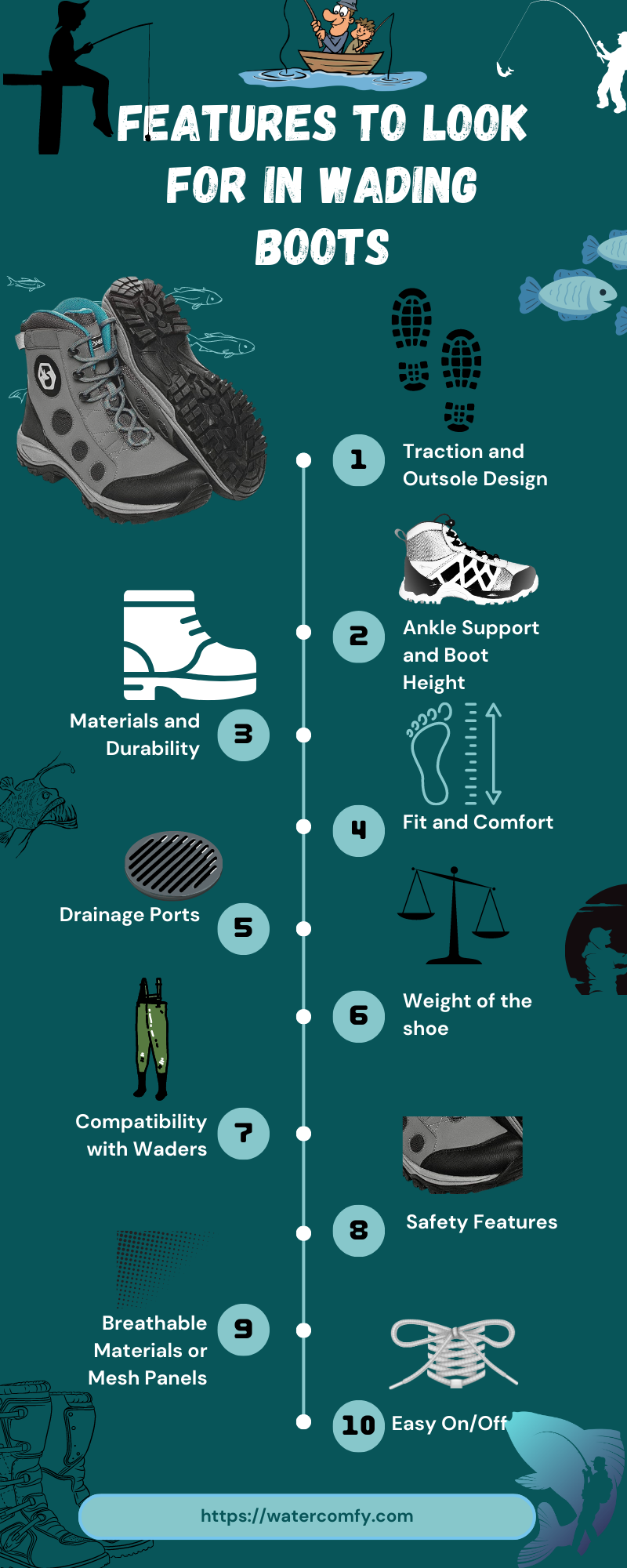
The Features To Look For In A Pair Of Wading Boots (What Are Wading Boots)
When searching for the perfect pair of wading boots, several key features should be taken into consideration to ensure a comfortable, safe, and enjoyable outdoor experience. Here are the essential features to look for:
1. Traction and Outsole Design
The most crucial feature of wading boots is their ability to provide excellent traction on slippery surfaces like rocks and algae-covered stones.
Look for boots with specialized outsoles made of rubber, felt, or studded patterns, as they offer superior grip on various terrains commonly encountered in water bodies.
2. Ankle Support and Boot Height
Wading boots should offer adequate ankle support to prevent injuries while walking on uneven and potentially unstable surfaces in water. A high-top design that extends above the ankle provides extra protection against water entering the boots and keeps debris out.
3. Materials and Durability
Opt for wading boots constructed with durable and water-resistant materials, such as synthetic fabrics or leather. These materials withstand the harsh conditions of aquatic environments, ensuring the boots stay functional for an extended period.
4. Fit and Comfort
Proper fit and comfort are essential for any footwear, especially when spending extended periods outdoors. Look for boots that offer a secure and comfortable fit, allowing for easy movement without causing discomfort or blisters.
5. Drainage Ports
Wading boots with built-in drainage ports help water escape from inside the boots, preventing them from becoming waterlogged and heavy during use.
6. Weight
Consider the weight of the boots, as heavy footwear can be tiring during long treks. Strike a balance between sturdiness and weight to find the most suitable option for your activities.
7. Compatibility with Waders
If you plan to wear waders, ensure that the boots are designed to be compatible with them, creating a seamless and watertight combination.
8. Safety Features
Look for additional safety features like reinforced toes or protective panels to shield your feet from sharp rocks or underwater obstacles.
9. Breathability
Proper ventilation is essential to prevent your feet from becoming sweaty and uncomfortable. Choose boots with breathable materials or mesh panels to enhance airflow.
10. Easy On/Off
Consider how easy it is to put on and take off the boots, especially if you’ll be wearing them frequently during your outdoor adventures.
READ ALSO: Are Crocs Good For The Beach- Unveiling the Ultimate Summer Companion
Best Wading Boots For Fishing (What Are Wading Boots)
Discover the ultimate gear for anglers seeking unparalleled stability and traction while conquering the waters. In this guide, we present the best wading boots for fishing, carefully curated to enhance your outdoor experience.
From rugged durability to advanced outsole designs, find the perfect pair to keep you sure-footed in any aquatic environment. Prepare to step into a world of comfort, safety, and seamless exploration with these best wading boots for fishing.

1. Foxelli Wading Boots
Foxelli Wading Boots are lightweight and comfortable wader boots designed to enhance your fishing or hunting outings. These durable boots offer reliable support, a true safe grip, and excellent traction in rocky streams.
Expertly designed with attention to detail, they provide easy on and off with lace hooks and a rubber kick log. Drain holes ensure quick water drainage, while the plaid nylon upper prevents debris from entering.
Enjoy the ultimate gear with a risk-free purchase, backed by a 120-day return window and a One Year Warranty.
Pros
- Soft microfiber material for comfort.
- Removable OrthoLite insoles for relief and protection.
- Shock-absorbent midsoles for joint impact reduction.
- Tear and abrasion-resistant plaid nylon for durability.
- Slip-proof rubber soles for stability on rocky surfaces.
- Rubber rand guards for toe protection.
- Lace hook and rubber kick log for easy on/off.
- Durable and super comfortable.
Cons
- Not available in half sizes. You want to size down.
- Limited color options.
- May not dry quickly.
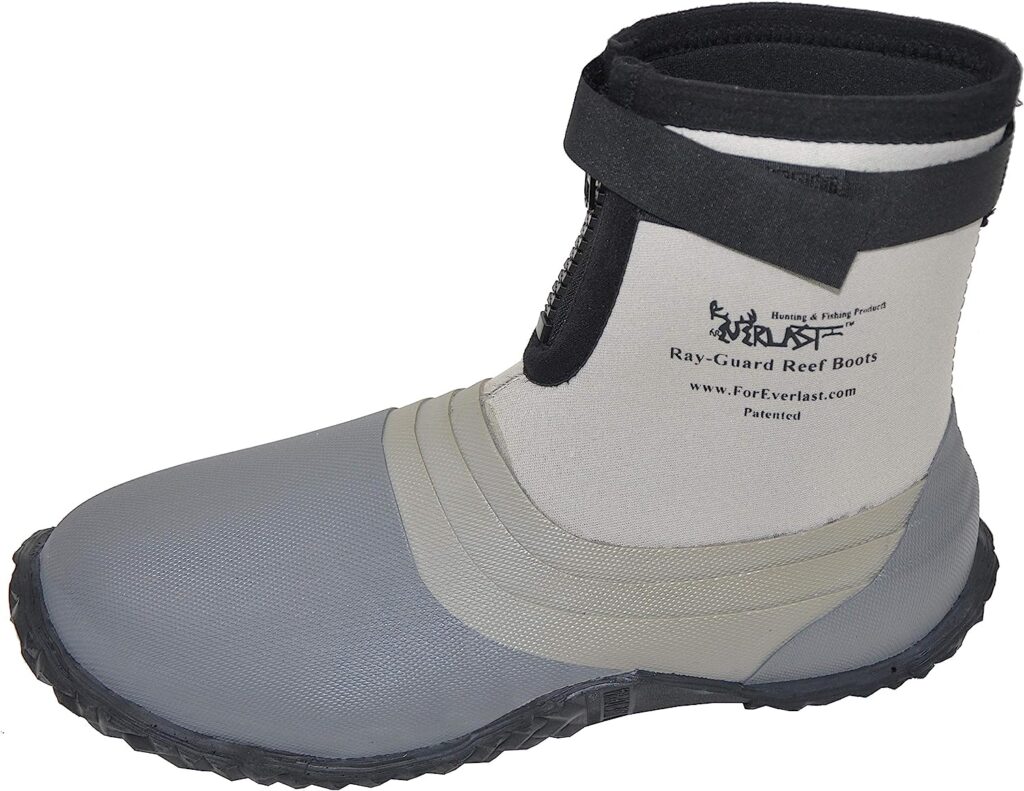
2. ForEverlast Ray-Guard Reef Wading & Fishing Boots
ForEverlast Ray-Guard Reef Wading & Fishing Boots – A top-tier choice for fishing enthusiasts, these boots offer the perfect blend of support, protection, and comfort. Navigate uneven river bottoms and reef structures with confidence, thanks to the hard-soled bottom with 4 layers of vulcanized rubber.
The lightweight design ensures ease of movement, while the venting system keeps excess water out. Enjoy a secure and personalized fit with the hook and loop cuff closure and zipper.
Pros
- Excellent support and grip for navigating uneven terrain.
- Hard-soled bottom with 4 layers of vulcanized rubber for superior protection.
- Lightweight and comfortable without compromising quality.
- Hook and loop cuff closure with added zipper for a secure fit.
- Strong ankle support for stability.
- Venting system to drain excess water from the boots.
- Water-resistant materials to keep you dry and prevent the spread of invasive water species.
Cons
- Limited color options.
- Sizing may run small for some users.
- Can be a bit heavy.

3. FROGG TOGGS Hellbender Felt Wading Shoe
FROGG TOGGS Hellbender Felt Wading Shoe is an amazing wading boot designed for fishing enthusiasts, offering versatile options with either felt or cleated soles. Enjoy exceptional traction on various surfaces, from wet rocks to muddy terrains.
The durable mesh and PVC upper provide water-draining capabilities and all-day comfort. With a focus on performance and affordability, these boots are designed to meet the needs of outdoor adventurers.
Pros
- Available with felt or cleated soles for versatile traction.
- Durable mesh and PVC upper for water draining and comfort.
- Polyurethane midsole for cushioned support.
- Wide wading last for added stability.
- Padded ankle collar for a comfortable fit.
- Speed laces with a locking lace clip for fast and secure fitting.
- Replaceable felt outsole for longevity.
Cons
- Limited color options.
- Some users may find the sizing runs small.
- Felt soles may wear out faster on abrasive surfaces.
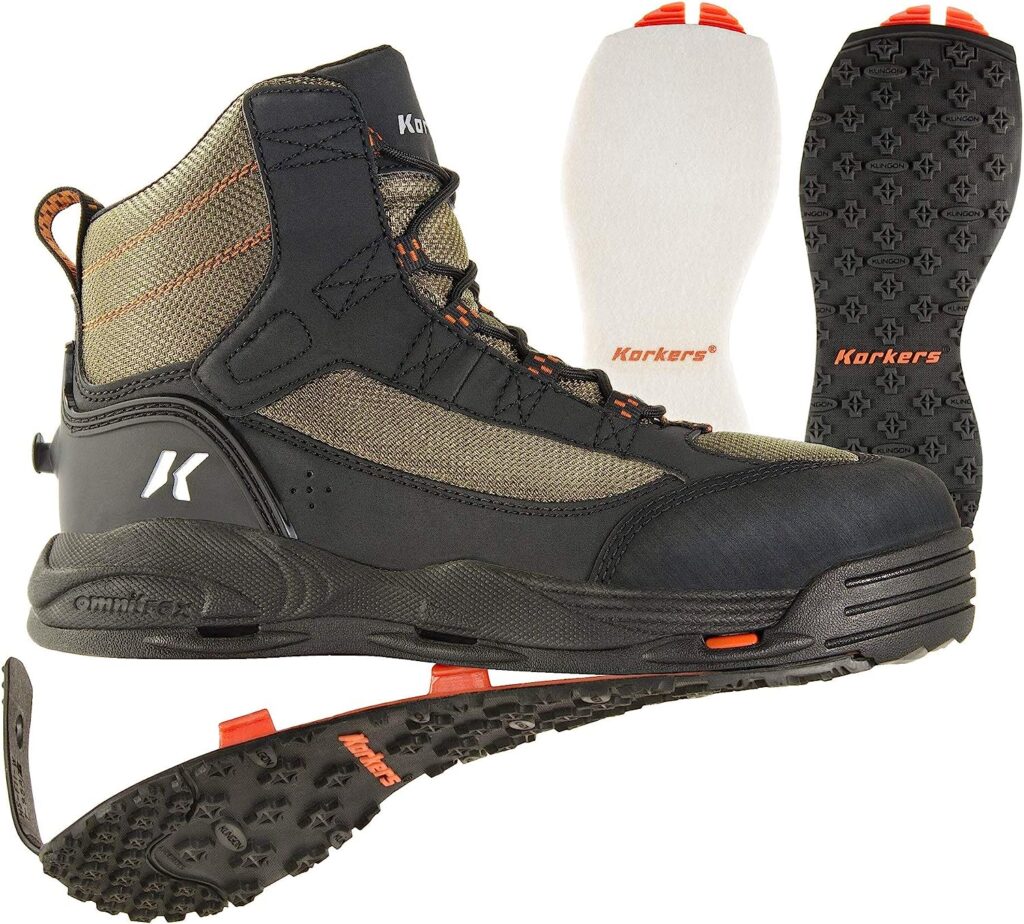
4. Korkers Greenback Wading Boot
Korkers Greenback Wading Boot – A top-tier wading boot tailored for fishing enthusiasts, offering versatile traction with the OmniTrax Interchangeable Sole System.
The Quick Cinch laces ensure a quick and secure custom fit, while hydrophobic materials facilitate fast drying and reduce the spread of invasive species. Enjoy internal drainage with water flowing through channels and midsole ports, swiftly removing excess water and weight.
Crafted with abrasion-resistant materials and strategic seam locations, these boots are designed for durability.
Pros
- OmniTrax Interchangeable Sole System for customizable traction.
- Quick Cinch laces for quick and secure fitting.
- Hydrophobic materials for faster drying.
- Internal drainage system to remove excess water and weight.
- Abrasion-resistant materials for enhanced durability.
- Seam locations strategically placed to minimize wear.
- Suitable for various fishing environments.
Cons
- Limited color options.
- Interchangeable soles may be challenging for some.
- Some users may find the sizing chart confusing.
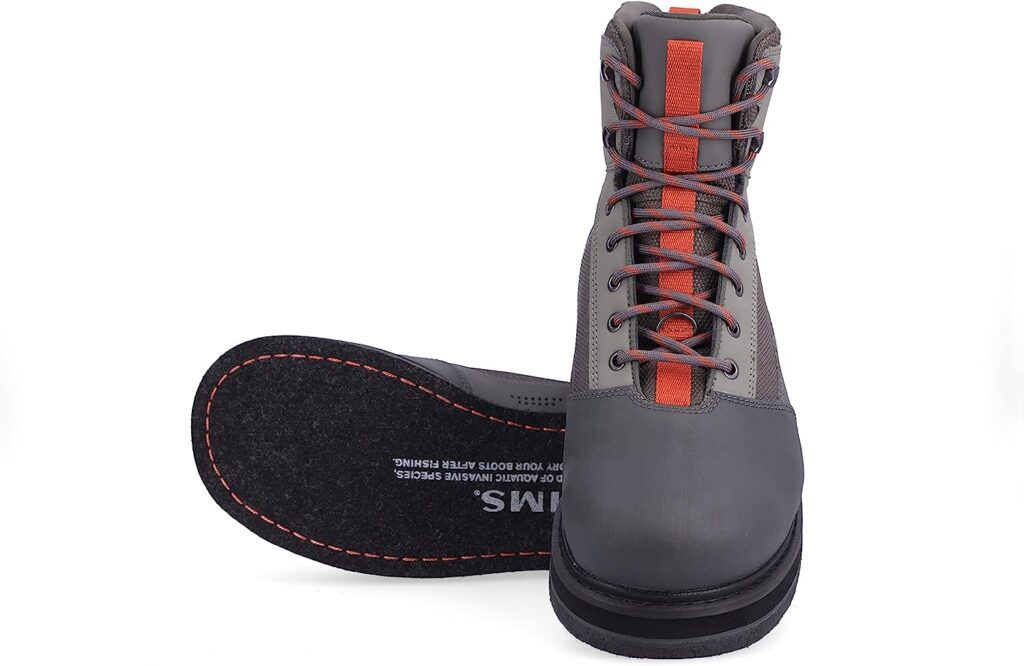
5. Simms Tributary Felt Sole Wading Boots
Simms Tributary Felt Sole Wading Boots provides you with trusted support and traction for navigating slick, uneven river bottoms. These boots feature a neoprene lining for easy on/off and a 12MM felt outsole for a firm grip on slippery surfaces.
With a durable rubber toe cap, your feet stay protected during rocky terrain exploration. Remember to follow proper wading footwear care for maximum longevity.
Pros:
- Textile and synthetic lace-up upper.
- Neoprene lining for easy on/off.
- 12MM felt outsole for excellent traction.
- Stud-compatible for added grip.
- Durable rubber toe cap for toe protection.
- Suitable for wet wading in saltwater.
- Easy to clean and maintain.
Cons
- Studs sold separately, adding to the cost.
- Limited color options.
- May not be as lightweight as some other models.
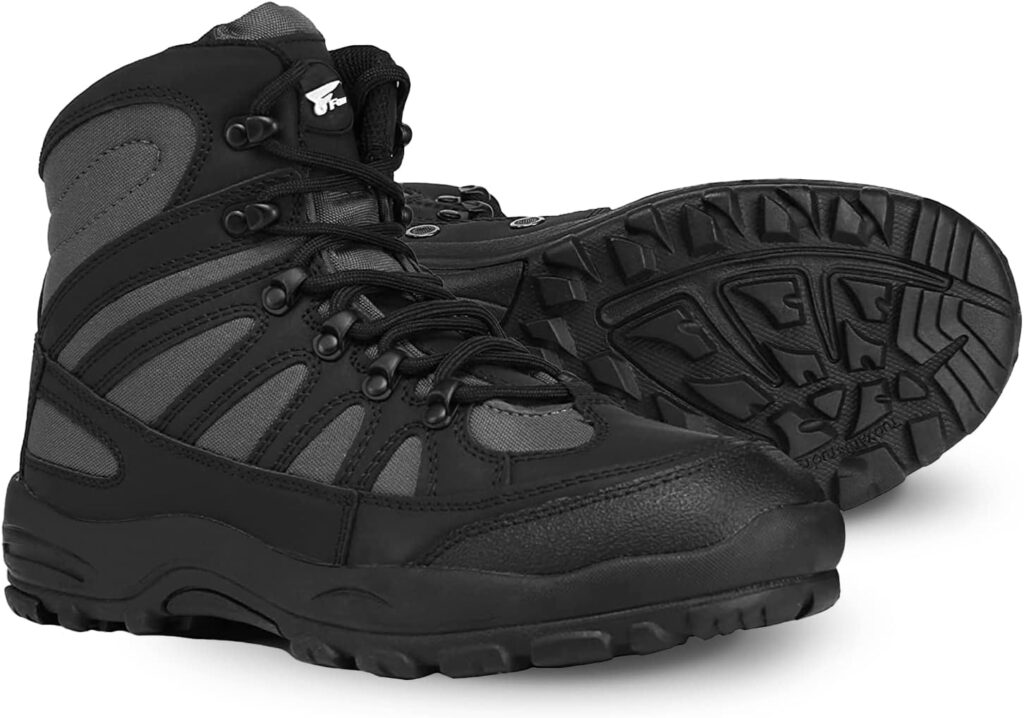
6. 8 Fans Men’s Fishing Hunting Wading Boots
These wading boots offer a customize fit with six American sizes available, ensuring a pleasant shopping experience.
Lightweight, comfortable, and quick-draining, these boots feature speed laces and durable tabs for easy on/off. The self-cleaning, anti-slip rubber outsole provides superior traction and slip resistance, while the reinforced toe and heel enhance durability.
Pros
- Available in six American sizes for a custom fit.
- Lightweight and superbly cushioned.
- Quick-draining design.
- Speed laces and durable tabs for easy on/off.
- Self-cleaning anti-slip rubber outsole for excellent traction.
- Padded ankle collar for extra support and protection.
- PVC upper with reinforced toe and heel for durability.
Cons
- Limited color options
- Some users may find the sizing problematic.
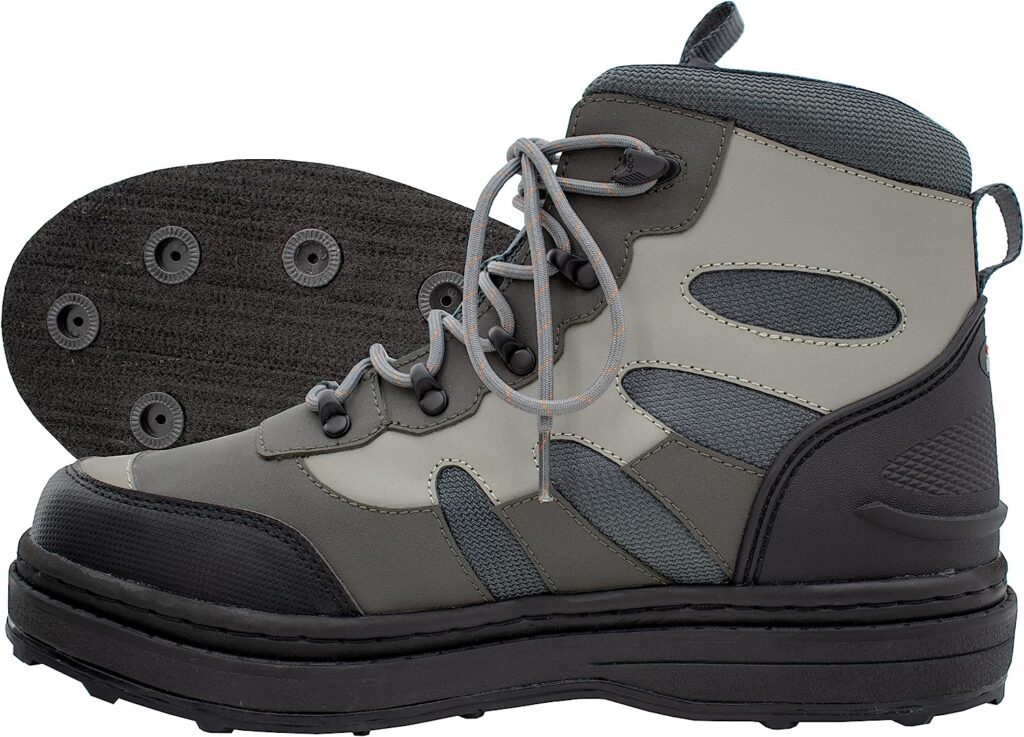
7. TOGGS Men’s Pilot Ii Wading Boot
These high-quality wading boots offer excellent traction on slippery surfaces with felt soles and recessed stud attachment points. The water-draining upper keeps the boot light and comfortable, reinforced with leather overlays for durability.
Enjoy extra comfort with a padded boot collar, reinforced toe cap, and removable quick-dry insole. The speed lace system ensures a secure and snug fit without fuss.
Pros
- Made with a combination of leather and mesh for durability and breathability.
- Trusted brand with a history of providing top rainwear and outdoor products.
- Felt soles with recessed stud attachment points for traction on slippery surfaces.
- Water-draining upper with 1200D Nylon and leather overlays.
- Padded boot collar for added comfort and support.
- Reinforced toe cap for enhanced protection and durability.
- Speed lace system for a secure and easy fit.
- Lightweight and comfortable.
Cons
- Limited color options.
- Sizing may run big for some users but it is generally true to size.
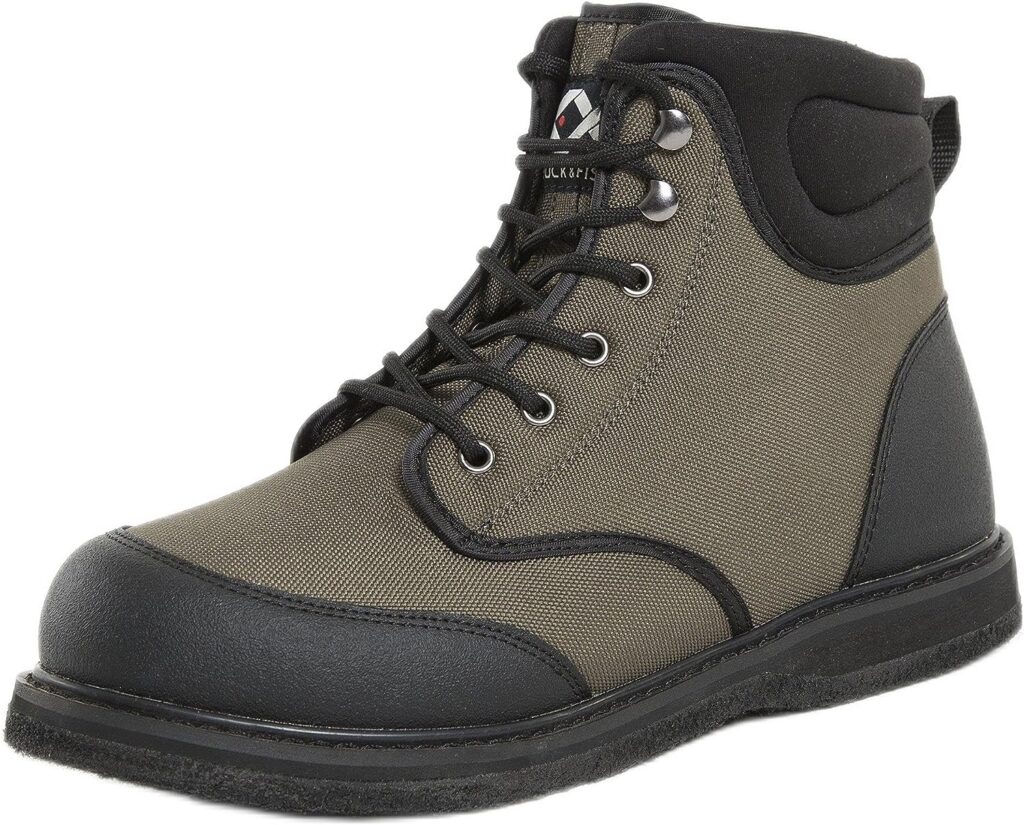
8. Duck and Fish Men’s Felt Sole Wading Shoe
Duck and Fish Men’s Felt Sole Wading Shoe is a top-notch wading boot known for its excellent traction with a one-piece felt outsole. The neoprene triple padded collar offers extra ankle support, while the reinforced PVC toe cap and back counter enhance durability.
With an extra-wide last and midsole, these boots provide a stable base, and the EVA midsole ensures comfort. Enjoy easy on/off with the pull top feature.
Pros
- One-piece felt outsole for superior traction.
- Neoprene triple padded collar for extra ankle support.
- Reinforced PVC toe cap and back counter for durability.
- Extra wide last and midsole for a stable base.
- Suitable for ordering your normal shoe size.
- EVA midsole for added comfort.
- Pull top for easy on/off.
Cons
- Limited color options.
- Some users may find the felt sole wears out faster on abrasive surfaces.

9. Chota Outdoor Gear, Hybrid High Top Rubber Soled Wading Boots
Chota Outdoor Gear, Hybrid High Top Rubber Soled Wading Boots is the ultimate versatile wading boots with a durable rubber sole and reinforced heel & toe. These lightweight boots feature large micro screen drain panels and synthetic uppers that do not retain water.
Enjoy all-day comfort with the cushy PU midsole. The dual-purpose removable insole system allows for a custom fit, and the quick lace system provides a simple and secure fit, perfect for anglers, hunters, and hikers.
Pros
- Hybrid high-top design with durable rubber sole.
- Padded ankle collar for protection and support.
- Lightweight, weighing less than 1 lb.
- Large micro screen drain panels for quick water drainage.
- Cushy PU midsole for all-day comfort.
- Dual-purpose removable insole system for a custom fit.
- Quick lace system for easy and secure fitting.
Cons
- Limited color options.
- Sizing may run big for some users.
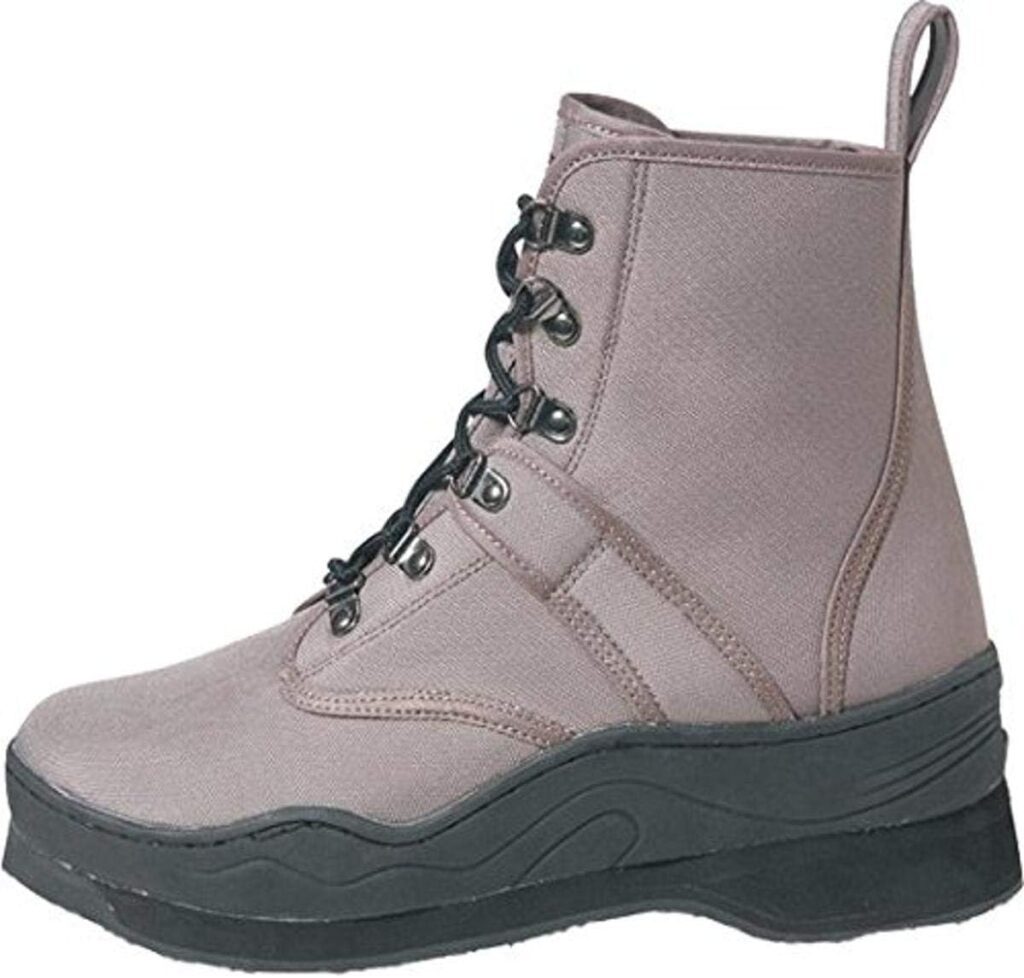
10. Caddis Men’s Taupe Felt Sole Wading Shoe
Caddis Men’s Taupe Felt Sole Wading Shoe is a comfortable and reliable felt sole wading shoe with speed laces, cushioned insole, and reinforced toe and heel. Designed to prevent slipping on mossy rocks, logs, or gravel bottoms, making it suitable for various wading conditions, including fishing and roofing.
Crafted with high-quality durable Polyester outer for long-lasting use. Please check your state fishing regulations for the use of felt soles. These wading shoes are slightly oversized to accommodate the neoprene booty and required insulation.
Pros
- Comfortable felt sole wading shoe.
- Speed laces for easy and quick fitting.
- Cushioned insole for added comfort.
- Reinforced toe and heel for enhanced durability.
- Suitable for various wading conditions.
- High-quality durable Polyester outer.
- Slightly oversized to accommodate insulation.
Cons
- Limited color options
- Felt soles may wear out faster on abrasive surfaces.
- Some users may find the sizing chart confusing. You may want to size down.
Benefits Of Wading Boots (What Are Wading Boots)
Wading boots offer a range of advantages over regular footwear, making them a crucial gear for anyone venturing into water bodies for fishing, hiking, or other outdoor activities. Here are the key benefits of using wading boots:
1. Improved Traction
Wading boots are equipped with specialized outsoles, often made of rubber or felt, designed to provide excellent traction on slippery and uneven surfaces.
This enhanced grip allows you to maintain stability and confidently traverse through rocky riverbeds, mossy surfaces, and other challenging terrains found in water bodies.
2. Reduced Slipping
With their superior traction and slip-resistant features, wading boots significantly reduce the risk of slipping and falling while wading. This added safety factor is particularly important in fast-flowing rivers or streams, where maintaining balance is critical.
3. Foot Protection
Wading boots are constructed with sturdy materials, including reinforced toe caps and durable soles, to shield the feet from sharp rocks, hidden debris, stingrays and underwater obstacles. This protection prevents injuries and ensures a more comfortable and enjoyable experience.
4. Comfort during Long Hours
Wading boots are designed with comfort in mind, providing proper ankle support and cushioning to minimize foot fatigue during long hours of wading. The added support reduces strain on the feet, ankles, and joints, enabling you to stay out longer without discomfort.
5. Water Drainage
Many wading boots incorporate drainage systems, such as drain holes or mesh panels, which allow water to escape quickly. This feature keeps the boots lightweight and helps prevent water from accumulating inside, ensuring a more agile and enjoyable wading experience.
6. Customizable Fit
Wading boots often come with lacing systems or quick cinch closures that enable you to achieve a snug and secure fit. This customized fit adds to the overall comfort and stability, allowing you to focus on your activities without worrying about ill-fitting footwear.
7. Durability and Longevity
Designed to withstand the rigors of water-based adventures, wading boots are crafted from high-quality and water-resistant materials. Their durable construction ensures they can withstand repeated exposure to water and rough terrains, providing lasting performance over time.
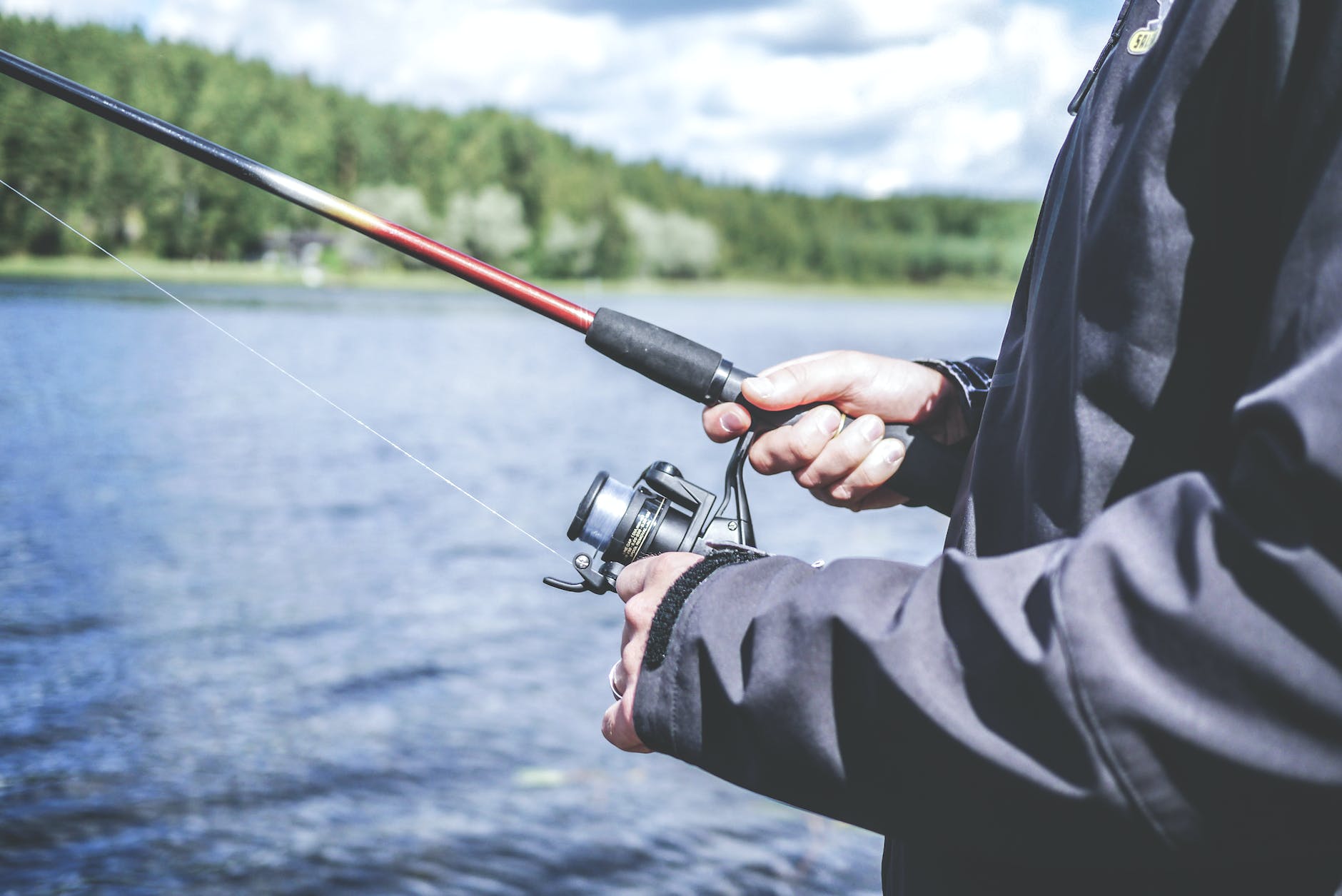
The Dangers Of Not Wearing Wading Boots (What Are Wading Boots)
Not wearing wading boots while engaging in water-based activities can expose individuals to various dangers and hazards. Here are some of the risks associated with not wearing proper wading boots:
1. Lack of Traction: Regular footwear, such as sneakers or sandals, often lacks the specialized outsoles found in wading boots. Without the proper traction, you are more susceptible to slipping and losing your footing on slippery and uneven riverbeds or rocks. This can lead to falls, injuries, or even being swept away by strong currents.
2. Foot Injuries: Wading without proper footwear leaves feet vulnerable to injuries caused by sharp rocks, submerged debris, or underwater obstacles. Without the protection offered by sturdy wading boots, you may experience cuts, bruises, sprains, or even more severe injuries.
3. Reduced Stability: Wading boots provide ankle support and a stable base, enhancing balance and stability while walking in water. Not wearing wading boots can compromise stability, making it challenging to maintain balance and increasing the likelihood of accidents.
4. Inadequate Protection: Wading boots are designed to protect feet from external elements and potential hazards found in water bodies. Without this protection, you risk exposure to harsh environments, bacteria, parasites, and invasive species that could cause health issues.
5. Slower Movement: Wearing regular footwear can slow down movement and impede agility in water. Properly designed wading boots allow for efficient and comfortable wading, enabling you to navigate water bodies with ease and confidence.
6. Uncomfortable Experience: Without the appropriate support and cushioning provided by wading boots, you may experience discomfort, foot fatigue, and blisters during prolonged periods of wading.
7. Reduced Rescue Readiness: In case of emergencies or the need to assist others, not having the right footwear can hinder rescue efforts, making it challenging to reach individuals in distress or stabilize oneself in fast-flowing water.
8. Risk of Falling and Submersion: The lack of proper footwear increases the likelihood of falling in water, leading to unexpected submersion, especially in deeper areas where the footing is uncertain.
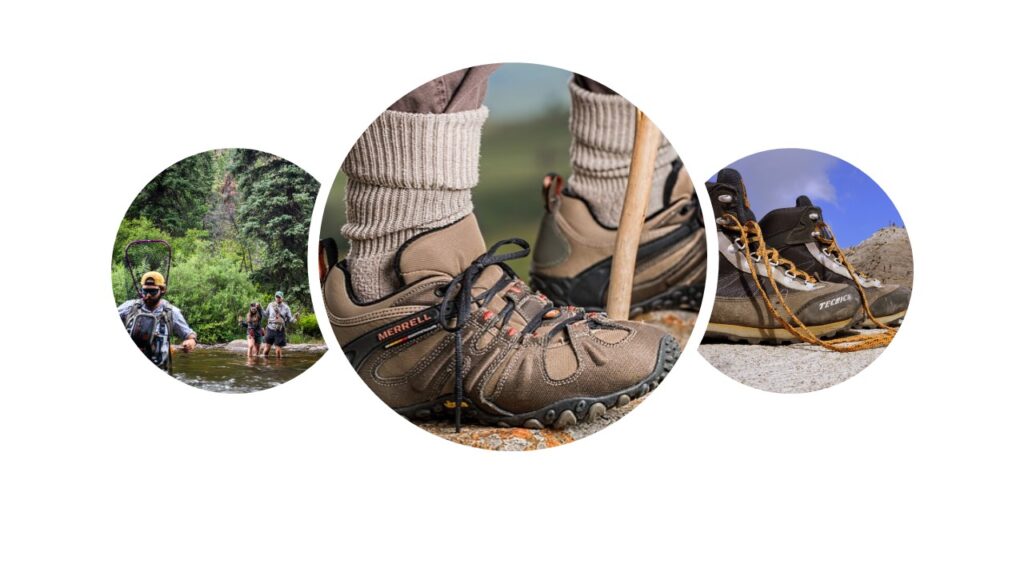
Types Of Wading Boots (What Are Wading Boots)
Wading boots come in various types, each designed to cater to different fishing and wading conditions. Let’s explore the three main types of wading boots available in the market:
1. Rubber-Soled Boots
Pros
Excellent Durability: Rubber soles are highly durable and can withstand the abrasion caused by rocky riverbeds and rough terrains.
Easy Maintenance: Rubber-soled boots are relatively easy to clean and require less maintenance compared to other types.
Versatility: These boots perform well in a wide range of conditions, from muddy riverbeds to gravel bottoms.
Cons
Limited Traction on Slippery Surfaces: While rubber-soled boots provide decent traction on most surfaces, they may not offer the same level of grip as felt or studded boots on very slippery rocks.
2. Felt-Soled Boots
Pros
Superior Traction: Felt soles are renowned for their exceptional traction on slippery surfaces, making them ideal for anglers navigating moss-covered rocks or algae-filled riverbeds.
Lightweight: Felt-soled boots are typically lighter than rubber or studded boots, providing more agility during wading.
Cons
Wear and Tear: Felt soles can wear down faster, especially on abrasive surfaces, leading to reduced traction over time. Some areas have banned felt-soled boots to prevent the spread of invasive species.
3. Studded Boots
Pros
Enhanced Traction: Studded boots provide the highest level of traction, especially on slippery rocks and challenging terrains, offering excellent stability and confidence during wading.
Longevity: The studs embedded in the soles increase the durability and longevity of the boots, providing prolonged use in rugged conditions.
Cons
Weight: Studded boots are generally heavier than other types due to the added metal studs, which might lead to fatigue during extended use.
Ultimately, the choice of wading boots depends on individual preferences, specific fishing conditions, and the environmental regulations in the area where one plans to wade.
Rubber-soled boots are versatile and easy to maintain, felt-soled boots offer excellent traction on slippery surfaces, and studded boots provide top-notch grip in challenging environments.
To make an informed decision, you should carefully consider your needs, the conditions you’ll encounter, and any local guidelines regarding wading boot usage to minimize environmental impact.
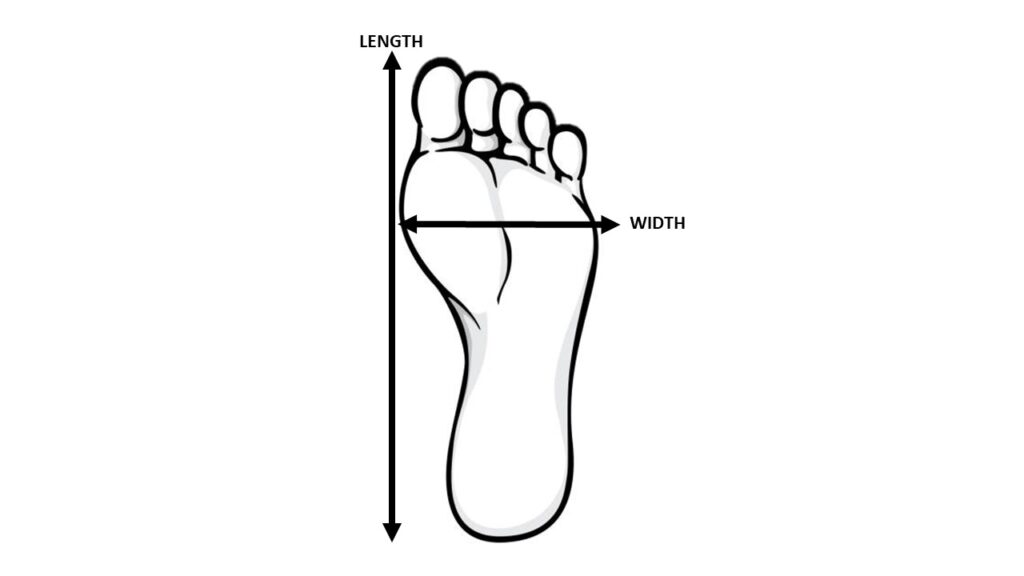
Choosing The Right Size And Fit For The Best Wading Boots (What Are Wading Boots)
Selecting the right size and fit of wading boots is crucial to ensure comfort, safety, and a pleasant wading experience. Here are some helpful tips to guide you in finding the perfect fit:
- Measure Your Feet: Start by measuring your feet using a Brannock device or a printable foot sizing chart. Measure both feet and go with the larger size if there’s a difference.
- Try with Wading Socks: When trying on wading boots, wear the type of wading socks you plan to use during your fishing trips. Wading socks are typically thicker than regular socks, and trying boots with them ensures you get the most accurate fit.
- Consider Foot Width: Pay attention to the width of the boots. If your feet are wide, look for boots with a wider design or consider sizing up to accommodate your foot width comfortably. Avoid boots that feel too tight or constricting, as they can lead to discomfort and blisters.
- Arch Support: Look for wading boots with adequate arch support to ensure proper alignment and reduce foot fatigue during extended hours of wading. Good arch support provides stability and prevents strain on your feet and lower legs.
- Toe Wiggle Room: Ensure that you have some wiggle room for your toes in the front of the boots. Your toes should not be crammed or touching the front, as this can cause discomfort and numbness.
- Heel and Ankle Support: Check if the boots offer sufficient support around the heel and ankle area. Proper support in these areas reduces the risk of ankle injuries and provides a secure fit.
- Try with Waders: If you plan to wear waders with your wading boots, try them on together to ensure they fit comfortably. Make sure there is no excess material bunching up, which can cause discomfort or irritation.
- Walk and Test: Take a few steps in the boots and walk around to assess their comfort and fit. Pay attention to any pressure points or areas that feel too tight or loose.
- Personal Comfort: Comfort is paramount when choosing wading boots. Everyone’s feet are unique, so prioritize your personal comfort over anything else. If a particular brand or model feels comfortable and provides the necessary support, it may be the right choice for you.
Remember, your feet might swell during long days of fishing, so it’s essential to have a bit of extra room in the boots. Consider trying on different brands and models to find the one that offers the best combination of size, fit, and comfort for your individual needs.
A well-fitted pair of wading boots will ensure you can focus on your fishing adventures without being distracted by discomfort or ill-fitting footwear.
How To Wear Wading Boots (What Are Wading Boots)
Wearing wading boots properly is essential for comfort, safety, and effective use during water-based activities. Here’s a step-by-step guide on how to wear wading boots:
1. Choose the Right Size: Select wading boots that fit your feet comfortably, allowing enough room for your wading socks without being too loose. Consider factors like foot width and arch support to ensure the best fit.
2. Wear Wading Socks: Put on the appropriate wading socks before putting on the wading boots. Wading socks are typically thicker and designed to provide additional comfort and cushioning during long hours of wading.
3. Loosen the Laces: Loosen the laces of the wading boots to open up the mouth of the boot, making it easier to slide your foot inside.
4. Insert Your Foot: Carefully slide your foot into the boot, making sure your toes are properly aligned with the front of the boot. Push your heel firmly into the back of the boot to ensure a snug fit.
5. Tighten the Laces: Begin lacing up the boots from the bottom eyelets, making sure the laces are threaded evenly through each eyelet. As you lace up, pull the laces snugly to provide a secure fit without being too tight.
6. Adjust Ankle Support: If the boots have ankle support features, adjust them to provide the desired level of support for your ankles.
7. Check Toe and Heel: Ensure that your toes have enough room to move and are not pressed against the front of the boot. Also, check that your heels are securely held in place without excessive movement.
8. Test Fit and Walk: Once the boots are laced up, stand up and walk around to test the fit. Pay attention to any areas of discomfort or pressure points that may need adjustments.
9. Use Wading Belt (If Applicable): If you’re wearing waders, don’t forget to put on a wading belt to secure the top of the waders and prevent water from rushing in if you accidentally fall.
10. Wading Staff (Optional): If you’re navigating challenging terrain or fast-moving water, consider using a wading staff for added stability and support.
11. Check for Proper Fit: Throughout your activity, periodically check the laces to ensure they remain tight and the boots maintain a snug fit.
Caring and Maintenance For The Best Wading Boots (What Are Wading Boots)
Proper care and maintenance of your wading boots are essential to prolong their lifespan and ensure optimal performance during your fishing adventures. Follow these guidelines to keep your wading boots in excellent condition:
1. Cleaning Procedures
- After each use, rinse your wading boots thoroughly with fresh water to remove dirt, sand, and debris. Pay special attention to the areas with drainage features, such as drain holes or mesh panels, to ensure they are clear of any blockages.
- Use a soft brush or cloth to gently scrub the boots, especially if there are stubborn stains or dirt buildup.
- For felt-soled boots, take extra care to clean the felt soles, as they can accumulate debris.
- Avoid using harsh chemicals, bleach, or abrasive cleaners, as they can damage the materials and affect the performance of the boots.
2. Drying Tips
- After cleaning, let your wading boots air dry thoroughly. Avoid exposing them to direct sunlight or high heat sources, as this can cause the materials to deteriorate and may lead to premature wear.
- Stuff the boots with newspaper or paper towels to help absorb excess moisture and speed up the drying process.
- If you need to dry the boots quickly, use an electric fan.
3. Storage Recommendations
- Store your wading boots in a cool, dry place away from direct sunlight and extreme temperatures.
- Avoid storing the boots in a damp environment, as it can promote mold or mildew growth and cause unpleasant odors.
- Ensure that the boots are completely dry before storing them to prevent any moisture-related issues.
- If possible, store the boots in an upright position or hang them to maintain their shape and prevent any deformation.
4. Inspect Regularly
- Periodically inspect your wading boots for signs of wear, damage, or loose components, such as laces or eyelets. Address any issues promptly to prevent further damage and maintain the boots’ performance.
- Check the traction features, such as studs or cleats, to ensure they are securely attached and replace any missing or worn-out traction components.
Importance Of Safety While Wearing Wading Boots (What Are Wading Boots)
Safety should be a top priority for anyone wearing wading boots while engaging in fishing or other water-based activities. Here are some essential safety considerations to keep in mind:
1. Water Conditions and Hazards
- Always stay aware of the water conditions and be cautious when wading in unfamiliar areas. Pay attention to the water flow, depth, and currents, as they can change rapidly and pose risks.
- Be mindful of underwater hazards such as submerged rocks, fallen trees, jellyfish and other obstacles that could cause tripping or entanglement.
- Avoid wading in fast-moving or deep water if you are inexperienced or uncertain about your abilities.
2. Footing and Stability
- Test your footing before taking each step. Use your wading staff or walking stick to probe the riverbed and check for solid ground or potential hazards.
- Take slow and deliberate steps, ensuring each foot is firmly planted before moving the other. Shuffle your feet when walking to maintain stability and avoid losing your balance.
3. Wading Staffs or Belts
- Consider using a wading staff for added stability, especially in fast-flowing water or challenging terrain. A wading staff can provide an extra point of contact and help you maintain balance.
- Wear a wading belt to secure your waders and prevent water from rushing into them if you accidentally fall or slip. This also helps improve buoyancy in case you find yourself in deep water.
4. Buddy System
Whenever possible, go wading with a fishing buddy or inform someone about your plans and estimated return time. Having someone aware of your whereabouts can be crucial in case of emergencies.
5. Watch Your Step
Take care when wading on slippery surfaces, mossy rocks, or algae-covered riverbeds. These areas can be particularly hazardous and increase the risk of slipping and falling.
6. Emergency Preparedness
- Familiarize yourself with basic water safety and rescue techniques, such as how to perform self-rescue or assist someone else in distress.
- Carry a whistle or signaling device to attract attention if needed.
7. Know Your Limits
Be honest about your swimming and wading abilities. Avoid pushing yourself beyond your comfort level, especially in challenging or hazardous conditions.
8. Weather Awareness
Keep an eye on weather forecasts and be prepared for sudden changes in weather conditions, as they can impact water levels and currents.
Remember, safety is paramount when wearing wading boots, and being prepared and cautious can significantly reduce the risks associated with wading and water-based activities. Enjoy your time in the water, but always prioritize your safety and that of others around you.
The Bottom Line On What Are Wading Boots
What Are Wading Boots? They are essential gear for any fishing enthusiast venturing into water-based activities. Offering superior traction, foot protection, and stability, wading boots ensure a safe and comfortable wading experience.
Don’t compromise on safety or performance; invest in quality wading boots to make the most of your fishing adventures. Happy wading!
